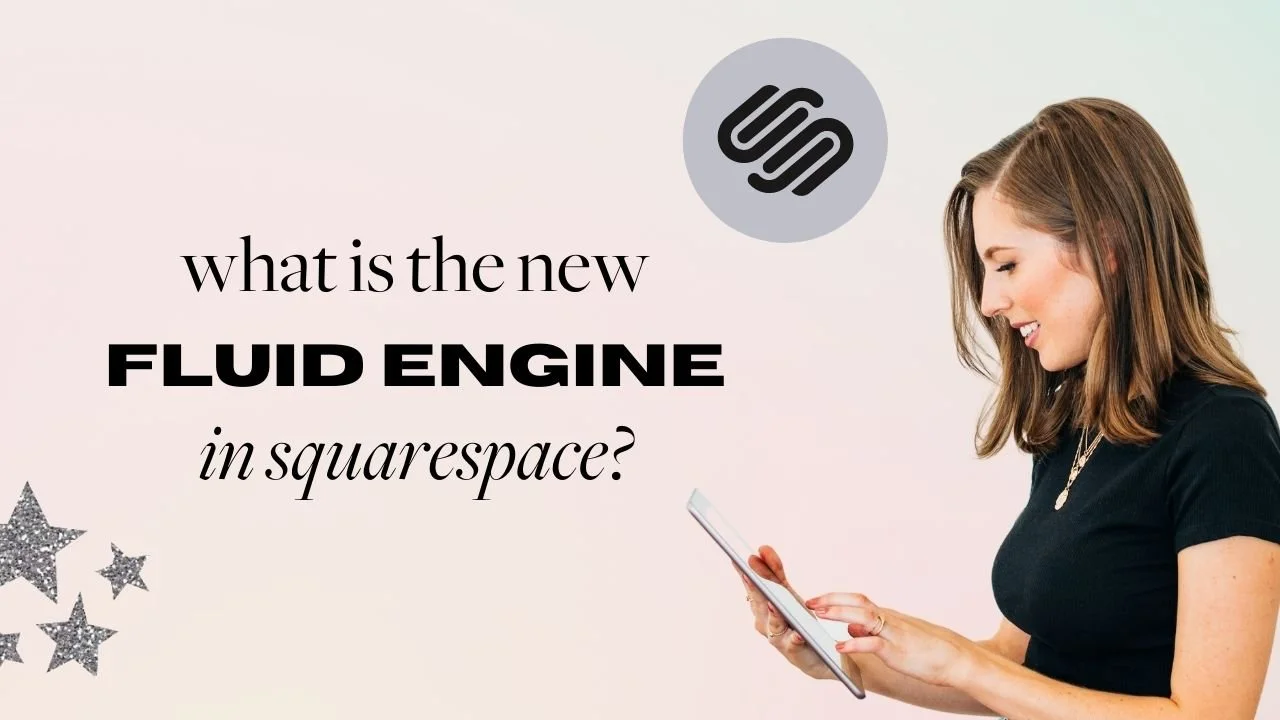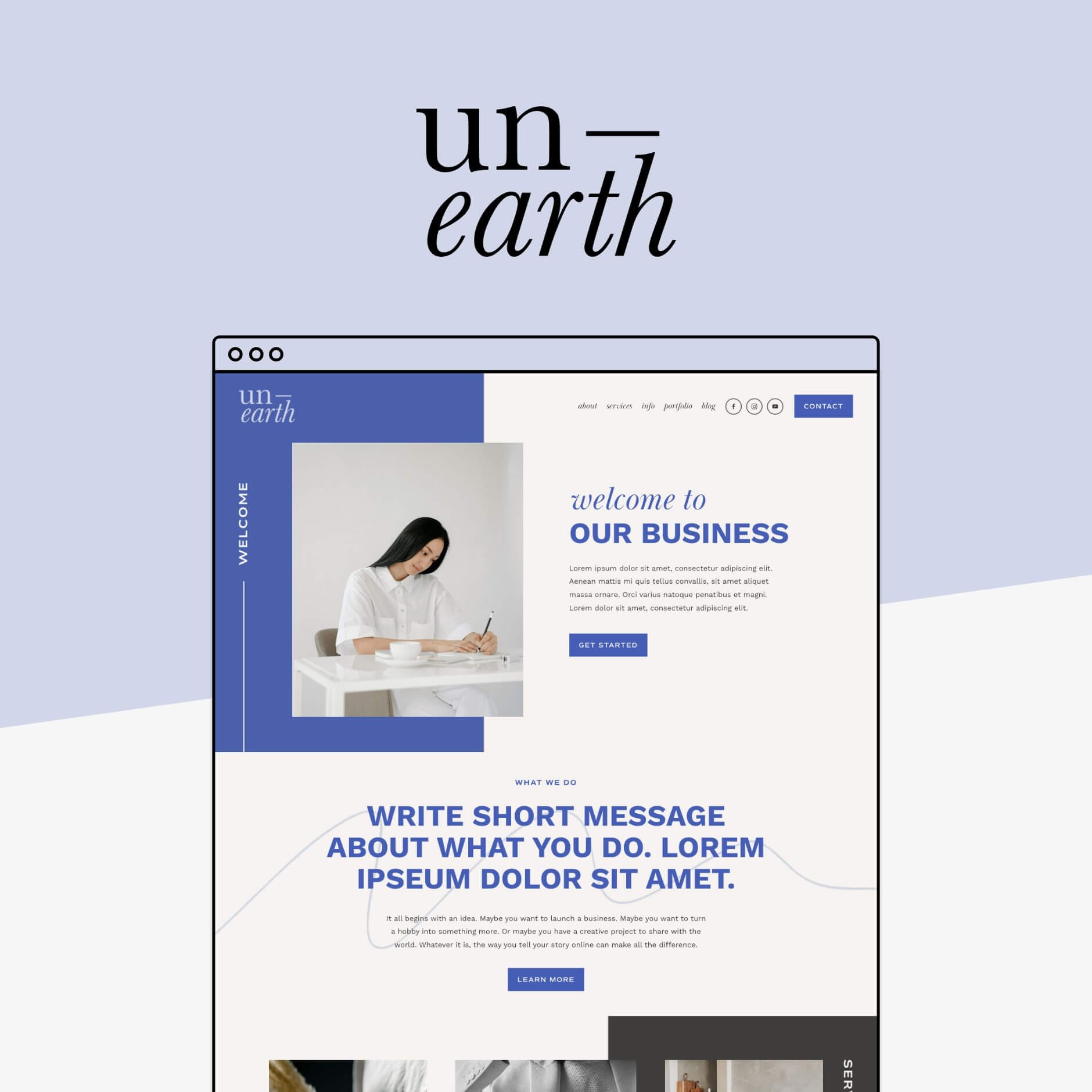What is the new Fluid Engine Editor in Squarespace, and should I use it?
In late June 2022, Squarespace announced that they were launching the Fluid Engine: a new type of editor for Squarespace 7.1 websites. This editing engine will be a content editor for regular page sections that use blocks. The idea is that it’ll allow for more flexibility in block placement, resizing, overlap options, and really creative layouts.
If you’ve been working in Squarespace for a while, you might be familiar with the Classic Editor. The Classic Editor is what Squarespace’s come to be known for with its simple content blocks (Image, Text and Spacer Blocks) that snap into place to make designing pages pretty easy, and most importantly, pretty hard to mess up!
Well, Squarespace has decided that the Classic Editor no longer cuts it. With the internet moving towards a more interactive, UX-heavy space, the company decided that their editing technology needs to keep up with the other web design heavy-hitter (see WebFlow, Showit, Divi Theme etc). Hence, the introduction of Fluid Engine (and the imminent elimination of the Classic Editor!) for Squarespace 7.1 sites.
Basically, the Fluid Engine is a new and much more flexible way to edit in Squarespace 7.1.
It's important to note that Squarespace 7.0 sites will still use the Classic Editor for now.
So, now that you have a better understanding of what the Fluid Engine editor is, let’s dive a little deeper into the pros and cons of this new technology and whether or not you should use it.
Pros of Squarespace Fluid Engine Editor
It's much more flexible
The biggest benefit to Squarespace’s new Fluid Engine editor is that it’s very flexible. A website is an absolute necessity in today’s world of business but because the market is so saturated, it’s hard to stand out. What sets your website (and business) apart from your competitors is design, functionality, and ease-of-use: all things that Squarespace hopes to address with this new editor.
This point is a HUGE pro and is hard to elaborate on without showing you all around the new editor. If you haven’t had a chance to play around with Fluid Engine yet I recommend starting a new 7.1 trial site and giving it a go.
For a long time, Squarespace marketed itself on very simple, templated designs. While this was great for cornering the market on entrepreneurs and small businesses that wanted guaranteed simple, clean websites without the design background to create them for themselves, Squarespace has decided that they want to give their DIYers more customizations and editing control.
Squarespace’s new Fluid Engine Editor gives entrepreneurs and small businesses the flexibility to creatively present content in a way that makes sense for their business.
So while this point seems pretty quick to cover, it holds a lot of weight. Flexibility is a huge factor in design and being able to just create what you want to create without having to custom code or jump through hoops is pretty incredible. And with this new editor, while it’s still lacking a few things here and there, compared to the Classic Editor, you can just do so much more.
Separate mobile editing!
Another huge asset to Squarespace’s new Fluid Engine editor is its separate mobile editing functionality.
Squarespace’s Classic Editor automatically adapts existing desktop designs for mobile screens and while this is convenient, it’s also really restrictive because you have no control over the way content blocks are displayed.
There are so many people browsing websites on their phones, that mobile design is just as important, if not more important, than your desktop site these days.
The Fluid Engine’s mobile editor is almost completely separate from desktop, meaning that you can move everything independently for mobile and it doesn’t affect your desktop site. This definitely requires a bit of extra work, as you’re almost designing two different designs per page, but in this day and age, with the importance of both desktop and mobile views, this kind of editing is necessary and I think a HUGE step up for Squarespace.
With the Fluid Engine Editor’s new mobile editing capabilities, it’ll be easier to optimize your web design for the mobile screen. This makes it easier for potential clients to navigate your website and obtain the information that they need, which thereby increases your conversion rate down the line.
Cons of Squarespace Fluid Engine Editor
Too many options?
With more options comes more overwhelm. One of the biggest drawbacks of this new Fluid Engine editor is that because there are so many more design options, it’s can be harder to learn and may be overwhelming for beginner designers to pick up.
When you’re given aesthetic flexibility, you really have to have a strong understanding of balanced design to make smart creative decisions that support your business’ needs.
Because of this, we might start to see some DIYers getting frustrated with ALL of the options, or creating site that maybe have TOO much going on. The great thing about the Classic Editor was that, while it was quite limited, you could very quickly create a basic site, and it was pretty hard to mess up.
If you’re diving into Fluid Engine and trying to build a site from scratch, I would maybe look into starting with either a free Squarespace Template or purchasing one of our Premium Templates. This will help you get the main layout for your design sorted and you can just tweak from there. As starting from scratch in Fluid Engine might be pretty overwhelming!
It needs perfecting
Because this Fluid Engine editor is still in the early stages of development, there are some weird glitches that Squarespace is still ironing out.
It’s pretty common for Squarespace to launch these things, in my opinion, before they’re fully baked.
The roll-out will likely be a work in progress and Squarespace will probably make updates along the way, which is very common.
So, if you’re using Fluid Engine and you see something that doesn’t seem right, or even just doesn’t seem intuitive, please submit a support ticket through Squarespace. The more tickets they get, the higher they will prioritize fixing something or changing something.
Should I use Classic Editor or Fluid Engine?
So, we’ve looked at the pros and cons…now, should you use it?
Well, we’re sorry to break it to you, but because Squarespace is slowly phasing out the Classic Editor, you essentially have no choice. Your existing site will likely convert to the Fluid Engine editor in the next few months or it may already have. The best next step is to hone in on your skills and master this new editor.
But what happens to my existing site? Will it break?
Don’t worry! Your existing site will stay the same unless you decide to “convert" or "upgrade" your sections to the new Fluid Engine.
On your website sections you'll probably see a button hovering over them - this button will change your Classic Editor section to a Fluid Engine section. Heads up that when you convert a section over, you won’t be able to switch it back to Classic Editor though!
As part of the plan to slowly transition all sites into the new Fluid Engine editor, any new pages created will be on this new technology. The only way you’ll be able to access the Classic Editor moving forward is if you duplicate existing Classic Editor sections, duplicate pages with existing Classic Editor parts on it, or duplicate Classic Editor sites.
While we’re still in the early days of this new Fluid Engine editor, it seems like Squarespace is serious about this launch and it’s unlikely that we’ll stay in Classic Editor for long. The old engine will be phased out fairly quickly so we’ll need to adapt.
If you rarely make changes to your site, then you're probably safe to stay with the Classic Editor, but if you update your website regularly and are constantly creating new sections and pages, it’s inevitable that you will need to learn this new software.
We recommend hopping on the bandwagon early so that you can take your own time in figuring it all out!
But before you go and convert all your sections over, we recommend testing the Fluid Engine editor out on either new pages or less significant sections. It’s quite different and the last thing we want is to convert the whole website over without actually being able to edit it in the way that we want!
How do I learn the new Fluid Engine editor?
As always, we'll be pumping out tutorials for you here on our blog and youtube channel, so keep an eye our for our weekly+ posts and tutorials!
If you want those tutorials directly to your email inbox, make sure you sign up to our email list.
And best all, ALL of our Squarespace 7.1 Templates have been adapted for the new Fluid Engine! In the template process we take you through super in-depth tutorials, so if you want to be taken through the step by step of Fluid Engine and get a beautiful website template to start with (so you don't have to start from scratch!) check out our Squarespace Templates for 7.1 Fluid Engine below.
Shop Squarespace 7.1 Fluid Engine Templates:
Overall, we think this is a massive change for Squarespace! Is it the right move for their current DIY audience? Only time will tell! But overall the new Fluid Engine editor is pretty darn awesome, and it's going to create some beautiful websites!
If you liked this post, Pin it to Pinterest! 👇🏻



















